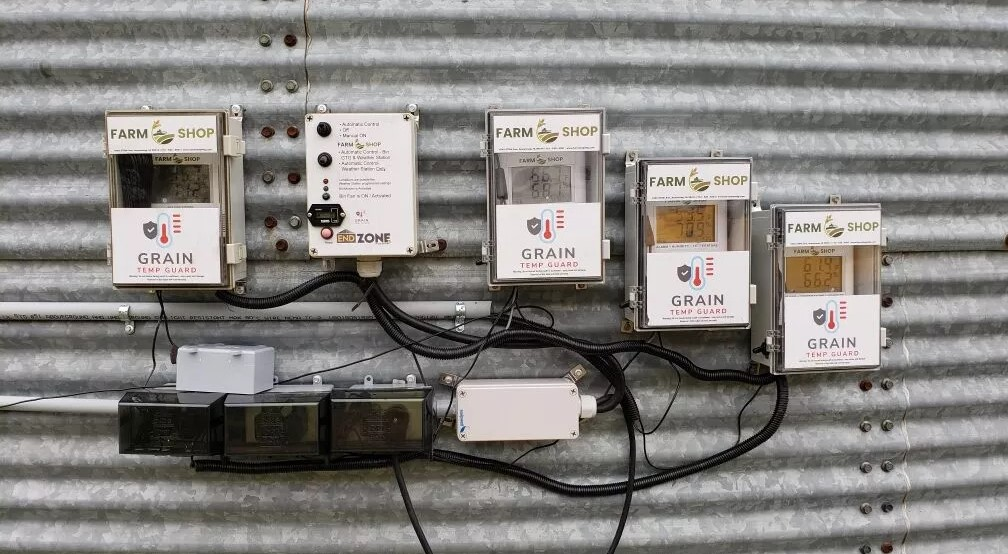Why Grain Temperature Monitoring is Crucial for Safe Grain Storage?
Grain temperature is the most sensitive barometer of quality because it responds immediately to biological and environmental changes within the storage bin. Ignoring this vital metric is like flying blind, leaving your valuable grain vulnerable to unseen threats. Farmers and operators face unprecedented challenges: larger bins, longer storage durations, and grain harvested with higher moisture content. These factors amplify the risks of spoilage and financial loss.
To meet these challenges, precise our grain temperature monitoring has become indispensable, not just for safety but also for optimizing operational efficiency and preserving grain value.

The Relationship Between Temperature and Grain Condition
Grain quality hinges on a balance between moisture, temperature, and time. While moisture sets the stage for potential problems, temperature acts as the trigger. When moisture pockets develop or biological activity intensifies, the grain mass heats up. This heat build-up, often invisible from the outside, signals increased respiration from insects, mold growth, or other microbial activity.
By detecting these temperature anomalies early, grain bin moisture management gains a critical window to intervene before quality loss escalates. In fact, temperature changes often precede any visible signs of spoilage, providing a proactive rather than reactive approach to grain management.
The Consequences of Neglecting Temperature Control
Failing to monitor grain temperature carefully can have cascading effects. Elevated temperatures accelerate biochemical processes that degrade grain quality, impacting taste, nutritional value, and marketability. Hot spots can rapidly expand, inviting insects and fungi that further compromise the grain. Eventually, the entire bin may require costly fumigation, drying, or even disposal.
With grain often stored for months or longer, these problems compound quickly. The financial consequences of spoilage include reduced sale prices, penalties for poor quality, and increased handling costs—all of which can be avoided with diligent temperature management.
Larger Storage Bins Demand Greater Precision
While consolidating grain reduces handling frequency and can lower certain costs, it also means that a single problem can affect a larger quantity of grain. Larger volumes also complicate airflow and temperature uniformity within the bin, creating zones where heat can accumulate unnoticed.
This complexity makes comprehensive temperature monitoring even more essential. Sensors placed strategically throughout a bin reveal these internal temperature variations, enabling targeted interventions rather than blanket treatments.
Efficient Aeration Depends on Accurate Temperature Data
Aeration is the primary tool to manage temperature and moisture in stored grain. However, running aeration systems without data can lead to wasted energy and unnecessary equipment wear. In contrast, temperature monitoring precisely identifies when and where aeration is necessary, enabling effective cooling of hotspots through optimized airflow.
This precision reduces energy consumption and extends equipment life, making aeration both environmentally and economically sustainable. Additionally, by aerating only when necessary, grain disturbance is minimized, preserving its structural integrity.
Leveraging Technology for Smarter Monitoring
Technological advances have revolutionized temperature monitoring. Modern grain bin moisture sensor systems provide continuous, real-time data accessible remotely via smartphones or computers. Alerts can be set to notify operators instantly of temperature deviations, enabling immediate action regardless of location.
These smart systems allow grain handlers to monitor multiple bins simultaneously, improving operational oversight and response times. Integration with automated aeration controls further enhances protection by creating a responsive storage environment that seamlessly adapts to changing conditions.
Protecting Your Grain Investment
Grain represents more than just a crop; it embodies time, effort, and financial resources. Ensuring its quality through precise temperature monitoring protects that investment. Early detection and targeted interventions reduce spoilage, maximize grain value, and prevent costly post-harvest losses.
Beyond economics, effective temperature management supports food safety and supply chain reliability, important factors in today’s agricultural markets.
Conclusion
In today’s agricultural landscape, safe and effective grain storage demands a sophisticated approach, with temperature monitoring at its core. The growing size of storage bins, longer storage durations, and harvesting at higher moisture levels all increase the potential for spoilage, unless temperature is vigilantly tracked and managed.
By embracing our grain temp guard system monitoring as your primary tool, you gain an early warning system that safeguards grain quality, optimizes aeration, cuts costs, and ensures your harvest is preserved at its best. Don’t underestimate the power of temperature, it’s the heartbeat of your grain storage, and with the right technology, you can keep it strong and steady.